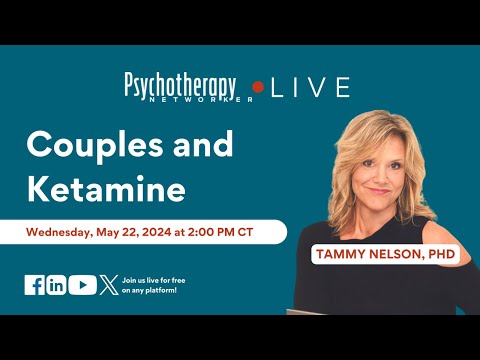On a cool Santa Cruz evening four months ago, therapist Dick Schwartz found himself crouched on a yoga mat in a friend’s living room, about to do something crazy. At least, that’s what some of his more buttoned-up colleagues might’ve thought. He’d met Bob Grant at an Esalen workshop several years back, a rising star in the field of ketamine-assisted therapy. Almost four decades earlier, Schwartz had developed Internal Family Systems (IFS), a therapeutic approach that involves dialoguing with our inner psyches, and he believed that ketamine, a longtime dissociative anesthetic said to have a quick-acting antidepressant side effect, was the key to taking his personal IFS work to the next level.
As Grant lit a fistful of sage and invited various invisible spiritual guides to join them in the room, he reassured Schwartz that he’d be beside him the whole time. Was he afraid, Grant asked? Schwartz shook his head and took a deep breath. Then Grant stuck a ketamine-filled syringe into the meat of Schwartz’s upper arm, and squeezed.
Within minutes, Schwartz became completely unaware of his surroundings. He entered another realm, he says, a blissful place, where his defenses crumbled and his heart opened up. The everyday problems we deal with, he suddenly realized, might seem all-encompassing, but they aren’t everything. “As the Buddhists would say, I felt less attached,” he explains. The hour-long experience seemed to end as soon as it began. Although he doesn’t remember saying it, as his mind gradually returned to his friend’s living room, he announced, almost mournfully, “This is amazing. I don’t want to leave.”
Schwartz was so enthralled with the experience that he decided to conduct a study with Grant and another Esalen colleague, Phil Wolfson, on the effects of ketamine in clients being treated with IFS for depression, which is currently in the planning stages. And he’s not alone in his enthusiasm. The number of American clinics where ketamine can be administered has spiked in just a few years, from approximately 60 in 2015 to 160 today, according to the American Society of Ketamine Physicians. And the Ketamine Advocacy Network suggests there are many more, since many providers ask to be omitted from online directories, avoiding controversy over the treatment and other factors.
Ketamine received FDA approval for use as an anesthetic in 1970 and saw action as a battlefield analgesic and emergency-room painkiller, treating everything from gunshot wounds to C-sections. But in 1999, the DEA declared ketamine a Schedule III controlled substance after it gained notoriety as a party drug, commonly known as Special K. In a press release last August, the American Psychiatric Association reiterated caution over ketamine’s widespread use due to its “potential for tolerance, abuse, and dependence.”
That hasn’t stopped the number of ketamine clinics from growing, particularly after several recent National Institute of Mental Health clinical trials found that 70 to 80 percent of participants with treatment-resistant depression reported no longer experiencing symptoms after receiving a series of ketamine infusions. And they felt this relief usually within hours of the first dose, as opposed to the four to six weeks it can take for the effects of most SSRIs to kick in. Unlike SSRIs, which target the brain’s serotonin and noradrenaline systems, ketamine targets the glutamate system, thought to restore neural connections that regulate mood and the ability to feel pleasure. For those who respond to ketamine, a typical treatment of six infusions can lead to a full recovery from depression symptoms for months at a time, according to a 2015 Lancet article. Still, most doctors acknowledge it’s not a standalone treatment, and follow-up boosters should be decided on a case-by-case basis, depending on how patients process ketamine and the severity of their symptoms.
So what does a clinical ketamine treatment look like? Patients can walk in, sometimes without a referral, do a short intake with the presiding medical professional, pay their fees, and schedule a handful of hour-long infusions several days apart. These infusions are given intravenously as patients sit in reclining chairs in private rooms. They’ll often listen to music or dim the lights to relax. An attendant will check on them every so often to measure their vitals. Throughout the infusion, patients remain mostly lucid. They can expect to dissociate a bit, clinic directors say, but not hallucinate, often experiencing feelings of weightlessness or floating outside of their body. Finally, since the patient can expect some residual dizziness after treatment, they get a ride home. For the most part, patients and providers say, it’s a painless and hassle-free experience.
While ketamine remains a legal but off-label antidepressant not approved by the FDA, esketamine, a variation of the ketamine molecule, was granted FDA approval for depression treatment in March, following years of legal wrangling. It’s now being sold as a nasal spray under the brand name Spravato, produced by Johnson and Johnson. Unlike ketamine administered intravenously, esketamine is likelier to be covered by insurance, thanks to the FDA endorsement. Although it’s less potent than pure ketamine, it still needs to be administered by a licensed doctor. And it will still carry a black box safety warning, the most serious warning issued by the FDA, reflecting its reported potential to impair thinking and judgment.
Many ketamine proponents are calling the FDA announcement a victory, and a much needed one, given that in 2017, more than 47,000 Americans died by suicide, the highest reported in more than 50 years. The New York Times, The Washington Post, Bloomberg, NPR, and numerous other mainstream media outlets have reported the FDA’s stamp of approval. With ketamine poised to be the biggest psychopharmacological advancement since Prozac, and a more effective one at that, many feel the early hype is warranted.
But Frank Anderson, a Boston-based therapist who also practices psychiatry, is cautious. “Work still needs to be done,” he says. Although he plans to get trained in ketamine-assisted psychotherapy, he says it’s unclear exactly what optimal treatment will look like. Since people who take ketamine enter an altered state, he says it makes sense for him to videotape all sessions for liability purposes. Plus, there doesn’t seem to be a consensus on what ketamine dosage is most therapeutic. Most clinics usually prescribe between half and one milligram per kilogram of body weight. For a 150-pound person, that’s about 35 milligrams—a little lower than the 50 milligrams Schwartz says he received in just a few seconds. (An anesthetic dosage is around 200 milligrams.) There are also wide variations in how long and often treatments are conducted. Some clinics see patients several times a week; others, once a week or monthly. Individual infusions last anywhere between 45 and 90 minutes, and some clinics prescribe booster sessions every six to eight weeks.
It’s unclear what role psychotherapists will play as ketamine continues to gain traction. Most ketamine clinics are managed by physicians, anesthesiologists, and nurses—and their sterile, no-frills clinics look more like dentists’ offices than places where you might expect deep psychological healing to occur. Although attending doctors usually require patients to fill out medical history forms and routinely assess their mood throughout treatment—and might consult with referring psychiatrists or give the patients’ therapists a rundown after each treatment—the experience is mostly devoid of any extended processing typical of psychotherapy.
That’s a problem, Anderson says. “Ketamine treatment isn’t psychotherapy assisted yet. In good therapy, you’re in a safe environment, and there are people supporting you.” It makes a huge difference in outcomes, he explains. “But that’s not the case at most IV clinics right now, where you get your ketamine and you leave. Instead of saying, ‘Take this drug and it’ll treat your depression,’ we need to be saying, ‘Take this drug, then let’s get to work to address your issues.’”
Patrick Oliver, the medical director of the Mind Peace Clinic in Richmond, Virginia, says incorporating therapy into their protocol is something many ketamine clinics, including his, are working toward. “Ketamine clinics are exploding,” he says, noting that he sees almost 50 patients a week, and the number is only growing. He’s watched almost three-quarters of his patients experience a full recovery, thanks to ketamine. He says the drug is a “game-changer,” but adds, “it’s not a get-it-and-forget-it treatment, where we ‘fix’ people. Depression, anxiety, trauma—these are chronic conditions we’re talking about. The long-term management of depression can’t be understated. It’s a crucial part of treatment.”
A former emergency medicine physician, Oliver switched jobs two years ago after becoming frustrated with the revolving door of suicidal clients in emergency treatment settings, where ketamine wasn’t used. He says he takes the mental health care component of his work very seriously, noting talk at the Mind Peace Clinic about bringing a social worker on board to help with intakes, and maybe even do a little psychotherapy before and after infusions. But at this stage in his new role, Oliver says he’s taking things one step at a time. For now, he calls his patients’ therapists after treatments to help them understand ketamine better and get a sense of how they might integrate the therapeutic gains into their work.
Other clinic directors, like Glen Brooks, in his seventh year managing a ketamine clinic in downtown New York, maintain there’s no need for accompanying onsite therapy. “I don’t see any reason why anybody would be moving toward it,” he says. Ketamine treatment in clinics isn’t about processing thoughts that come up during the dissociative trip, he explains: it’s about stimulating new dendritic and synaptic growth, and restoring connectivity between neurons and mood centers. In other words, the work is mostly biological. Brooks estimates that he’s treated more than 2,300 patients during his tenure at the clinic, and that most of them haven’t wanted or needed onsite therapy, especially since many were already seeing therapists on their own. “If I thought having someone sit there and talk about childhood trauma had any value,” he says, “I’d have done it.”
Still, Brooks frequently collaborates with his patients’ psychiatrists, who he estimates are now responsible for one-third to half of his referrals, a huge uptick from several years ago, when most patients self-referred. For those who do self-refer, he says that in the initial phone call he listens to confirm a history of depression before deciding whether to treat them. And if they do end up coming to his clinic, he spends another hour and a half going over their history and discussing what to expect during and after the infusion.
Brooks is also a veteran of addiction treatment, having spent years in detox medicine, and more recently working in the thick of the opioid epidemic. Like Oliver, he became frustrated treating co-occurring disorders like anxiety and depression with SSRIs, which he says do nothing but chase a chemical imbalance that doesn’t exist. “I knew I wasn’t helping anybody unless we were actually treating the underlying cause of the depression that was leading these people to self-medicate.” Within a month of hearing about ketamine’s effects on mood disorders from a colleague, he opened his own clinic.
Although Brooks says the winds have changed in favor of ketamine, it’s still fighting an uphill battle to clinical acceptance and adoption as a front-line treatment for depression, anxiety, and trauma. Although it’s been on the World Health Organization’s Model List of Essential Medicines for decades, it still often gets written off as a hallucinogenic party drug, tranquilizer, or highly addictive substance. These are stereotypes perpetuated by Big Pharma, Brooks says, since ketamine is off-patent, and nothing they have competes with it. Having also worked as an anesthesiologist for decades, he says he’s never seen a patient addicted to ketamine, and believes its hallucinogenic qualities—at least in clinical settings—are exaggerated. “The pharmaceutical industry keeps recycling the same drugs,” he says. “They’ll tweak them a little, but they mostly do the same thing. We haven’t seen something like ketamine in 50 years, and it’s got them running scared.”
Another ongoing barrier: cost. The average infusion can cost anywhere between $400 and $1,000. Even esketamine, which Johnson and Johnson reportedly spent almost $400 million pushing through clinical trials to get a nod from the FDA, is expected to set patients back somewhere between $600 and $900 for a single dose, since it can legally be administered only by accredited specialists, who are required to monitor clients’ vital signs for two hours after dosing to watch for negative side effects.
Brooks says he won’t be administering esketamine, nor does he expect most ketamine clinics to do so, once the drug rolls out. Why? Some studies report esketamine only has a 35 to 50 percent absorption rate, compared to IV ketamine infusions, which boast a 100 percent rate. Johnson and Johnson disputes these numbers, but if accurate, that leaves depression recovery estimates at around 30 to 40 percent of users—still better than most SSRIs, but half as effective as pure ketamine. “There’s a lot of buzz about esketamine, but press releases don’t mention the downsides,” Brooks says. “Plus, a lot of people think taking esketamine will be as easy as picking it up at your local CVS for home use. That ain’t happening.”
In the meantime, expect ketamine’s popularity to continue rising. For proof, proponents say, look no further than beneficiaries like Alexa. After two decades of grappling with crippling anxiety, depression, PTSD, and OCD, she walked into Patrick Oliver’s clinic three months ago with a referral from her psychiatrist. She’d been taking a rotating cocktail of meds that she says never seemed to work well, if they worked at all. “Let’s put it this way,” she explains sarcastically: “SSRIs worked so well that I only attempted suicide once a year.”
At first, Alexa admits that she was nervous about trying ketamine. After all, she’d heard rumors about its addictive properties, and she’d struggled with addiction in the past. But midway through her fourth infusion, as she lay in a reclining chair in one of Oliver’s dimly lit rooms, the ketamine slowly snaking its way through her IV tube and a Lady Gaga song playing gently in the background, Alexa felt an incredible weight lift from her shoulders. “It’s hard to explain,” she says. “I didn’t black out, and it wasn’t like an acid trip. It was more like I’d been wearing around a 100-pound backpack, and for the first time in 21 years, it felt like I was finally able to take it off.”
PHOTO © ISTOCK/BENJAVISA
Chris Lyford
Chris Lyford is the Senior Editor at Psychotherapy Networker. Previously, he was assistant director and editor of the The Atlantic Post, where he wrote and edited news pieces on the Middle East and Africa. He also formerly worked at The Washington Post, where he wrote local feature pieces for the Metro, Sports, and Style sections. Contact: clyford@psychnetworker.org.












